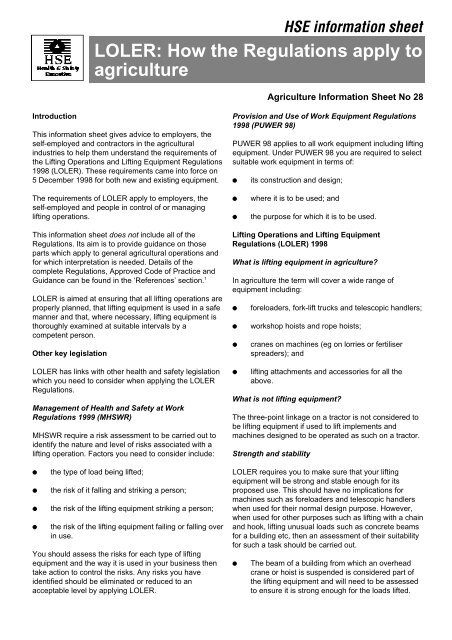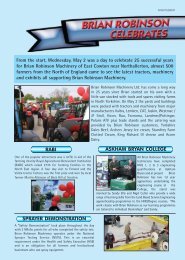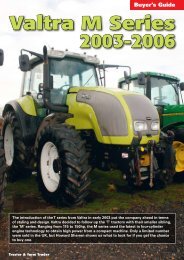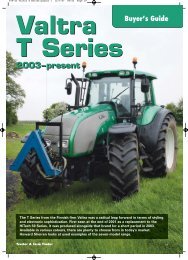HSE LOLER regulations factsheet - Brian Robinson Machinery
HSE LOLER regulations factsheet - Brian Robinson Machinery
HSE LOLER regulations factsheet - Brian Robinson Machinery
- No tags were found...
Create successful ePaper yourself
Turn your PDF publications into a flip-book with our unique Google optimized e-Paper software.
●●Lifting equipment should not be used on groundwhere the slope or surface characteristics maycreate a risk to the stability of the equipment unlesssuitable precautions are taken.The load and anything attached to it should also bestrong enough, eg if a load has a damaged palletbanded to it, it may need dismantling andrepacking.Lifting equipment for lifting peoplePeople should only be raised on work equipment whichis specifically designed for that purpose but can, inexceptional circumstances, be lifted by other machinesprovided that they have a purpose-made carrier suitablyconstructed and attached.Nobody should ever be lifted in a loader bucket, on theforks of a fork-lift truck or a similar attachment notdesigned for the purpose.Where a person in a carrier (work platform) might fall2 m or more:●●●●the carrier should be fitted with edge protectionwhich should be suitable for the purpose andshould be securely fixed to the carrier;the edge protection should be sufficiently high andbe either solid, mesh or, if in the form of rails,should have a top rail, intermediate rail and a toeboard;the lifting equipment to which the carrier isattached should have a device to prevent thecarrier becoming detached. This includes the basicattachment of the carrier to its lifting machine aswell as any other devices necessary, eg if a carrieris fitted on a telescopic loader the loader wouldneed to have a hydraulic lock-off valve for the tiltmechanism;a means of escape from the carrier should beavailable. This could include a ladder storednearby.Positioning and installationLifting equipment should be:●●positioned and installed to reduce to as low asreasonably practicable the risk of the equipment orthe load striking people or the risk from the loaddrifting, falling freely or being releasedunintentionally;positioned to minimise the need to lift loads overpeople, eg when lifting bulk fertiliser bags into aspreader;●fitted with suitable devices to minimise the risk fromthe load falling free. For example, a tractorforeloader or rear-mounted tractor fork-liftattachment fitted to a tractor which has no cab mayneed to have a protective barrier fitted at the backof the loader, high enough to prevent the loadfalling back onto the operator. (A roll bar, becauseof its position, will not provide enough operatorprotection as an alternative device for thispurpose.)Hooks or other devices provided for lifting should be ofa type that reduces the risk of the load becomingdisplaced from them, eg a hook should have a retainingcatch fitted wherever this is necessary for the safety ofthe operator or others.Marking of lifting equipment●●●●Machines used for lifting should have their safeworking load marked on them. Examples are acrane mounted on a fertiliser spreader or aworkshop hoist. A tractor foreloader would onlyneed marking when used for non-agriculturalpurposes or with accessories for which it is notdesigned, eg a lifting hook beam or a chain andhook.Where the safe working load depends on themachine’s configuration, then the operator willneed clearly visible information to keep bothmachine and loads within the safe working limitsfor any particular configuration, eg with a telescopicloader.Accessories should be marked with anyinformation needed for their safe use, eg a chainused for vertical lifting will need its safe workingload marking. Attachments such as buckets, forksand bale grabs are not classed as accessories.Any carrier for lifting people should clearly displaythe maximum number of people to be carried andits safe working load.Organisation of lifting operationsLifting operations should be properly planned,appropriately supervised and carried out in a safemanner. It is particularly important that:●●●people planning a lifting operation should haveadequate practical and theoretical knowledge andexperience of planning similar lifting operations;you should organise work so that where practicableloads should not be carried or suspended overpeople;where possible people should not walk or standunder loads that have been left suspended;
●workers should have sufficient training andinstructions so they can ensure that liftingequipment is safe to use. For example when anuntrained casual worker uses a foreloader, trainingshould be given on the daily checks needed toensure the safety of hydraulic fittings and mountingpoints for attachments and the loader.Thorough examinationLifting equipment may need to be thoroughly examinedby a competent person when:●it is first put into service;●●the first time it is put into service unless it has notbeen used before and has an EC declaration ofconformity not more than 12 months old, or it issecond-hand and has a current report of thoroughexamination;at the following intervals where it is exposed toconditions which could cause deterioration andresult in dangerous situations:- every six months for any equipment used forlifting people and for all accessories (such aschains and slings) and every twelve monthsfor other lifting equipment; or●●●following major refurbishment or repair;after installation at a new location; andat intervals suitable to detect deterioration arisingfrom wear and tear.Thorough examination is to protect both operators andpeople in the vicinity of lifting operations who may be atrisk if lifting equipment suddenly fails.Equipment which lifts loads over or in close proximity topeople should be thoroughly examined.Equipment that does not lift loads over or in closeproximity to people and where the operators of theequipment are protected does not need to be thoroughlyexamined. Such protection would be a safety cab.Working to the above criteria, lifting equipment such as:●●fork-lift trucks and foreloaders on tractors withoutadequate operator protection or where otherpeople are working in the close vicinity will needthorough examination; andforeloaders on tractors with safety cabs, telescopicloaders and fork-lift trucks with operator protectionand where no other people work in the vicinity willnot normally need thorough examination.While thorough examination of tractor foreloaders willnot normally be necessary, a regular check of aforeloader’s hydraulic hoses and mounting points forattachments should be part of normal safe operation andmaintenance.However, you should assess your work equipment andworking practices for the risks involved and decide whichitems need thorough examination in your particularcircumstances.Where lifting equipment is assessed as needing athorough examination, you should ensure that it is done:●- in accordance with the time intervals in anexamination scheme prepared by acompetent person;each time that exceptional circumstances occurwhich are liable to jeopardise the safety of thelifting equipment, eg after accident damage.When lifting equipment requires a thorough examinationyou will need to arrange for this to be carried out by acompetent person. This will normally be an independentcompetent person from outside the undertaking, such asan engineer.You should ensure that the competent person chosen tocarry out the thorough examination has the appropriatepractical and theoretical knowledge and experience ofthe lifting equipment concerned to enable them to detectdefects or weaknesses which it is the purpose of theexamination to discover. Also they should be able toassess the importance of the defects in relation to thesafety and continued use of the equipment.When any lifting equipment which requires a thoroughexamination under this regulation leaves your business,then a copy of its current thorough examination reportshould be available, eg if you hire a fork-lift for your ownuse or you lend yours to a neighbour.Reports and defectsA competent person making a thorough examination foryou should notify you immediately of any defect which isor could become a danger to people. The competentperson should also send a copy of the report to <strong>HSE</strong>where there is an existing or imminent risk of seriouspersonal injury. (Where the Local Authority is theenforcement body it should be sent to them instead.)If you are notified of a defect you should ensure that thelifting equipment is not used before the defect isrectified, or that it is rectified within the time specified inthe competent person’s report.
RecordsCopies of EC declarations of conformity for any liftingequipment should be kept for as long as the equipmentremains in use.Information contained in any thorough examinationreport should be kept available for inspection.References1 Safe use of lifting equipment. Lifting Operationsand Lifting Equipment Regulations 1998. ApprovedCode of Practice and Guidance L113 <strong>HSE</strong> Books 1998ISBN 0 7176 1628 2Further information<strong>HSE</strong> priced and free publications are available by mailorder from <strong>HSE</strong> Books, PO Box 1999, Sudbury, SuffolkCO10 2WA Tel: 01787 881165 Fax: 01787 313995Website: www.hsebooks.co.uk (<strong>HSE</strong> priced publicationsare also available from bookshops.)For information about health and safety ring <strong>HSE</strong>'sInfoLine Tel: 08701 545500 Fax: 02920 859260 e-mail:hseinformationservices@natbrit.com or write to <strong>HSE</strong>Information Services, Caerphilly Business Park,Caerphilly CF83 3GG. You can also visit <strong>HSE</strong>’s website:www.hse.gov.ukThis leaflet contains notes on good practice which arenot compulsory but which you may find helpful inconsidering what you need to do.This publication may be freely reproduced, except foradvertising, endorsement or commercial purposes. Firstpublished 11/98. Please acknowledge the source as<strong>HSE</strong>.Printed and published by the Health and Safety ExecutiveReprinted 5/02 AIS28 C150







